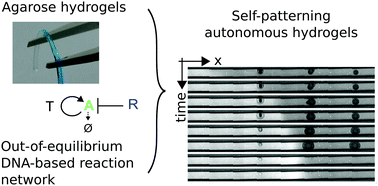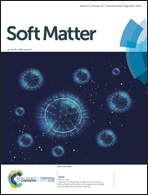DNA-based long-lived reaction–diffusion patterning in a host hydrogel†
Abstract
The development of living organisms is a source of inspiration for the creation of synthetic life-like materials. Embryo development is divided into three stages that are inextricably linked: patterning, differentiation and growth. During patterning, sustained out-of-equilibrium molecular programs interpret underlying molecular cues to create well-defined concentration profiles. Implementing this patterning stage in an autonomous synthetic material is a challenge that at least requires a programmable and long-lasting out-of-equilibrium chemistry compatible with a host material. Here, we show that DNA/enzyme reactions can create reaction–diffusion patterns that are extraordinarily long-lasting both in solution and inside an autonomous hydrogel. The life-time and stability of these patterns – here, traveling fronts and two-band patterns – are significantly increased by blocking parasitic side reactions and by dramatically reducing the diffusion coefficient of specific DNA strands. Immersed in oil, hydrogels pattern autonomously with limited evaporation, but can also exchange chemical information with other gels when brought into contact. Providing a certain degree of autonomy and being capable of interacting with each other, we believe these out-of-equilibrium hydrogels open the way for the rational design of primitive metabolic materials.



 Please wait while we load your content...
Please wait while we load your content...